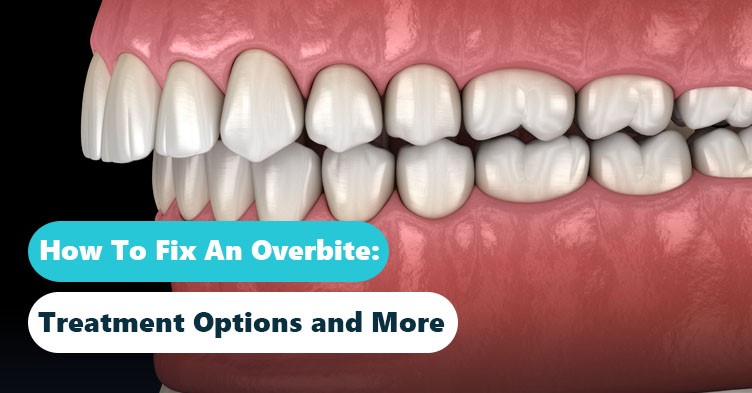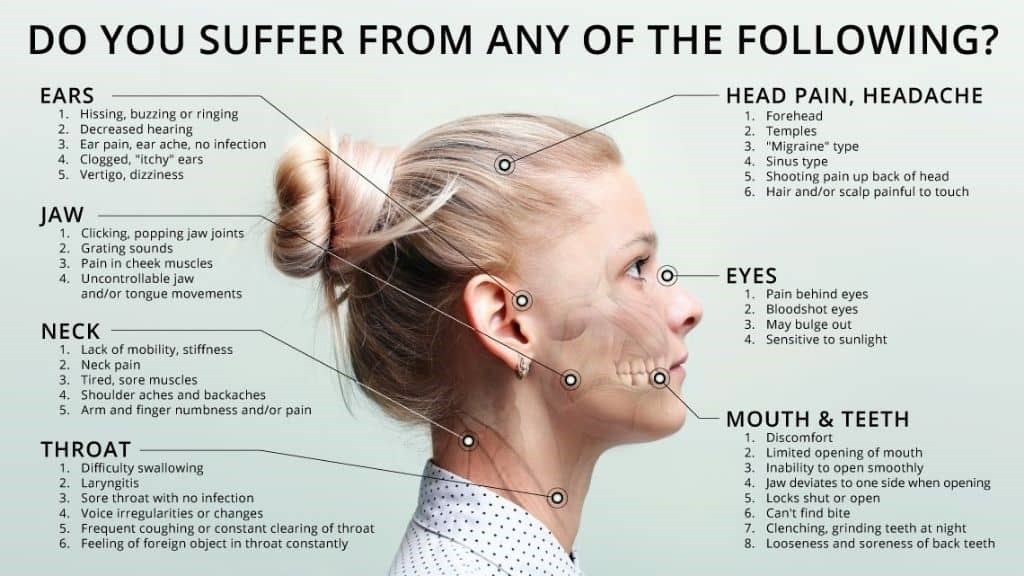A beautiful smile not only enhances our appearance but also contributes to our confidence and well-being. However, dental misalignments, such as overbites, can affect the harmony of our smiles and oral health. An overbite occurs when the upper front teeth overlap excessively over the lower front teeth. In this blog post, we will explore the five types of overbites and discuss effective ways to correct them, ensuring a healthy and radiant smile.

Understanding Overbites:
An overbite occurs when the upper front teeth overlap excessively over the lower front teeth. While a slight overbite is considered normal, a significant or deep overbite can lead to a variety of dental issues. These may include tooth wear, gum recession, speech difficulties, and problems with chewing and biting.
The Connection to TMJ
The temporomandibular joint (TMJ) acts as a hinge connecting the jawbone to the skull. When an overbite is present, the misalignment can affect the proper functioning of the TMJ. The excessive pressure exerted on the joint due to an improperly aligned bite can lead to TMJ disorders, causing pain and discomfort in the jaw joint and surrounding areas.

Causes and Symptoms of TMJ Disorders:
- Malocclusion: Overbites can contribute to TMJ disorders, as the misalignment places additional stress on the TMJ, leading to inflammation and discomfort.
- Teeth Grinding (Bruxism): Individuals with overbites may be more prone to teeth grinding, a habit that can exacerbate TMJ-related issues.
- Stress and Muscle Tension: Emotional stress and tension can result in jaw clenching, which puts strain on the TMJ and contributes to the development of TMJ disorders.
Common symptoms of TMJ disorders include:
- Jaw pain or tenderness
- Clicking or popping sounds when opening or closing the mouth
- Difficulty in fully opening the mouth
- Headaches or migraines
- Earaches or ringing in the ears
- Facial pain or fatigue
5 TYPES OF OVERBITES:
There are five types of overbites which are defined below.
1. Vertical Overbite:
Vertical overbite, also known as a deep bite, is characterized by excessive overlapping of the upper front teeth over the lower front teeth. This condition can lead to various dental problems, including tooth wear, gum recession, and temporomandibular joint disorders (TMJ). Correcting a vertical overbite typically involves orthodontic treatment. Braces or clear aligners are used to gradually reposition the teeth, bringing them into proper alignment and reducing the overbite. In severe cases, orthognathic surgery may be necessary to correct skeletal discrepancies
2. Horizontal Overbite:
A horizontal overbite, often referred to as a crossbite, occurs when the upper teeth bite inside the lower teeth. This misalignment can cause jaw asymmetry, tooth wear, and difficulty in biting and chewing. The treatment for a horizontal overbite varies depending on the severity and underlying causes. In mild cases, orthodontic appliances such as expanders or braces may be used to widen the upper arch and correct the crossbite. In more severe cases, a combination of orthodontic treatment and oral surgery may be recommended to achieve the desired outcome.
3. Dental Overbite:
Dental overbite, also known as a non-skeletal or dental protrusion, is characterized by the protrusion of the upper front teeth. It is often caused by factors such as genetics, thumb sucking, or tongue thrusting habits. Orthodontic treatment is the primary approach to correcting dental overbites. Braces, aligners, or other dental appliances are utilized to align the teeth properly, bringing the upper front teeth back into harmonious alignment with the lower teeth. In some cases, extractions of certain teeth may be required to create the necessary space for alignment.
4. Skeletal Overbite:
A skeletal overbite is a result of an underlying jaw discrepancy, where the upper jaw protrudes forward in relation to the lower jaw. This type of overbite is primarily caused by skeletal growth patterns and can lead to facial asymmetry and functional issues. Treatment options for skeletal overbites include orthodontics, orthognathic surgery, or a combination of both. Orthodontic treatment helps align the teeth, while orthognathic surgery repositions the jaws to achieve a balanced facial profile and improve the bite. The treatment plan is usually determined by an orthodontist and oral surgeon working together.
5. Open Bite:
An open bite is characterized by a lack of vertical overlap between the upper and lower front teeth when the back teeth are in contact. This condition can be caused by factors such as thumb sucking, tongue thrusting, or prolonged bottle feeding. It can lead to difficulties in biting, chewing, and speech, as well as aesthetic concerns. Treating an open bite may involve orthodontic treatment, jaw surgery, or a combination of both. Orthodontic appliances, such as braces or aligners, are used to close the open bite gradually. In severe cases, orthognathic surgery may be necessary to reposition the jaws and achieve a proper bite.
Seek Professional Advice
If you suspect that your overbite is causing TMJ-related discomfort, it is crucial to consult a qualified dental professional or orthodontist. At Top Nova Orthodontics, they stay at the forefront of the field, continuously introducing new treatments and technologies to effectively address even the most complex cases. By visiting our website, you can explore the latest innovations in orthodontics that we offer.

With a specialization in personalized treatment options for various orthodontic disorders, Dr. Abbasi and her team are highly skilled professionals. They possess extensive training and experience, enabling them to effectively treat conditions such as TMJ disorder and sleep apnea. By visiting Top Nova Orthodontics, you can familiarize yourself with the comprehensive range of treatment options available, allowing you to make informed decisions about your oral health.
By choosing Top Nova Orthodontics, you can be confident that you will receive exceptional care from a team that is dedicated to helping you achieve a beautiful and long-lasting smile. Trust Dr. Azita Abbasi and her experienced staff to provide personalized treatment plans designed to meet your unique requirements. Don’t hesitate to reach out to them and embark on your journey towards improved oral health.
CONCLUSION:
Overbites can contribute to the development of TMJ disorders, causing pain and discomfort in the jaw joint. Understanding the connection between overbites and TMJ is essential in seeking timely intervention and relief. By addressing the underlying dental misalignment, managing stress, and exploring available treatment options, individuals can alleviate TMJ-related symptoms and improve their overall oral health and quality of life. Remember, professional guidance is paramount in developing an effective treatment plan for long-lasting relief.


